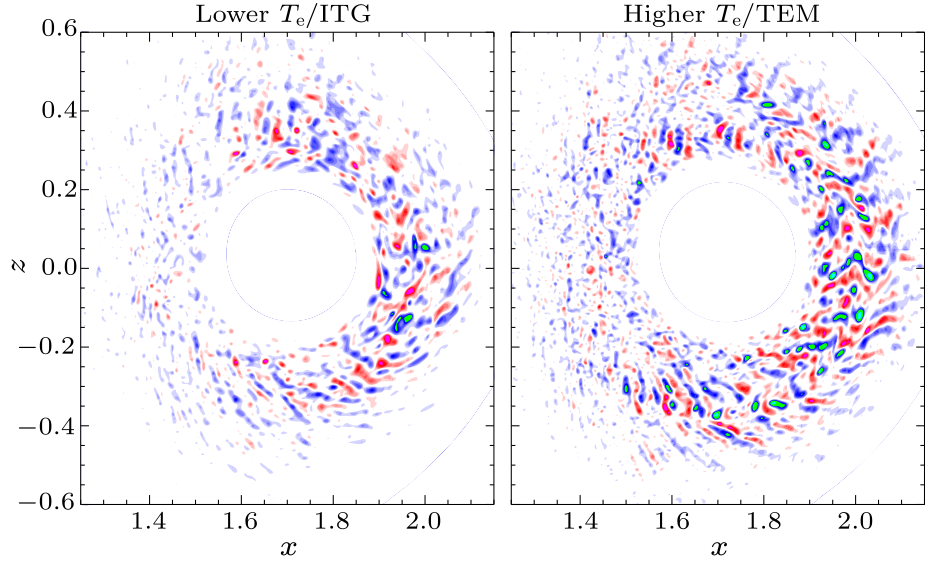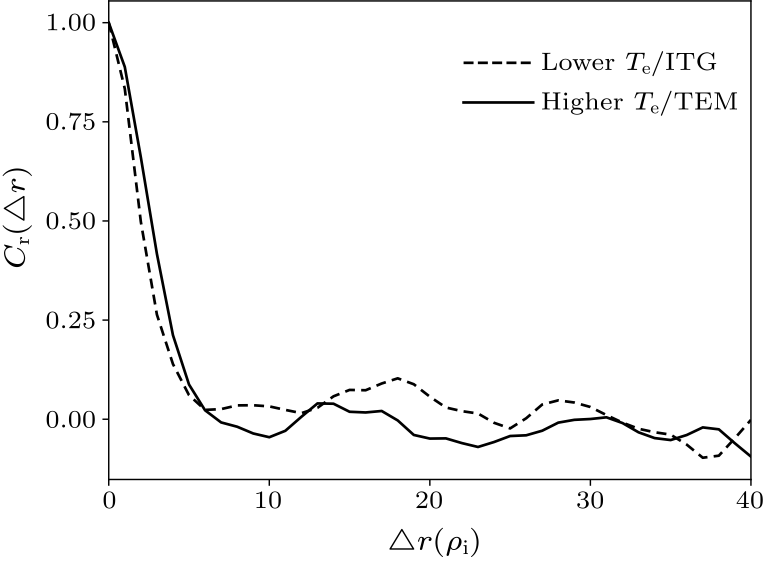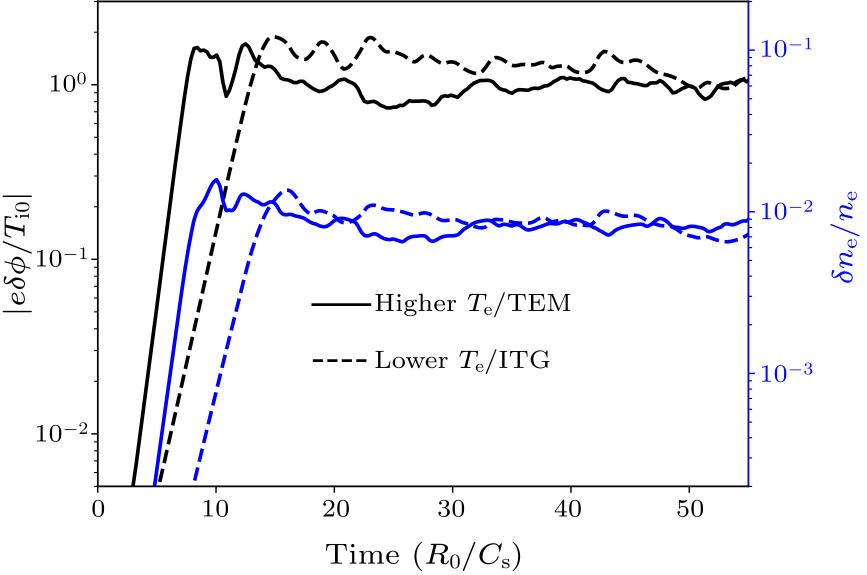
Fig. 1. The upper two figures are the mode structures of the perturbed potential in the poloidal cross section in the linear simulations with a fixed toroidal number $n$. The lower two are the frequency distributions of the most unstable poloidal modes, with the positive frequency referring to the TEM mode (right) and the negative frequency to the ITG mode (left).

Fig. 2. The global mode structures of the perturbed potential in the poloidal cross section in the nonlinear saturated stages in the two simulations.

Fig. 3. The radial correlation length versus the radial distance in the nonlinear saturated stages in ITG and TEM microturbulences.

Fig. 4. The wave spectrum distributions of perturbed potential versus perpendicular wavenumber in the linear and nonlinear stages in ITG and TEM microturbulences.

Fig. 5. Evolution of the average perpendicular wave vector lengths and their respective spectrum width in the two simulations. The average perpendicular wave vector value decreases from the linear stage to the nonlinear stage.

Fig. 6. Comparisons of the perturbed potential intensities and the electron density fluctuation intensities in ITG and TEM microturbulences.
| [1] | Lin Z and Hahm T S 2004 Phys. Plasmas 11 1099 | Turbulence spreading and transport scaling in global gyrokinetic particle simulations
| [2] | Xiao Y and Lin Z 2009 Phys. Rev. Lett. 103 085004 | Turbulent Transport of Trapped-Electron Modes in Collisionless Plasmas
| [3] | Dimit A M, Bateman G, Beer M A, Cohen B I, Dorl, W, Hammett G W, Kim C, Kinsey J E, Kotschenreuther M, Kritz A H, Lao L L, Mandrekas J, Nevins W M, Parker S E, Redd A J, Shumaker D E, Sydora R and Weiland J 2000 Phys. Plasmas 7 969 | Comparisons and physics basis of tokamak transport models and turbulence simulations
| [4] | Ryter F, Angioni C, Peeters A, Leuterer F, Fahrbach H U and Suttrop W 2005 Phys. Rev. Lett. 95 085001 | Experimental Study of Trapped-Electron-Mode Properties in Tokamaks: Threshold and Stabilization by Collisions
| [5] | Vlad M, Spineanu F, Itoh S I, Yagi M and Itoh K 2005 Plasma Phys. Control. Fusion 47 1015 | Turbulent transport of ions with large Larmor radii
| [6] | Chen L 1999 J. Geophys. Res.: Space Phys. 104 2421 | Nonlinear gyrokinetic Vlasov equation for toroidally rotating axisymmetric tokamaks
| [7] | Zhang W, Lin Z and Chen L 2008 Phys. Rev. Lett. 101 095001 | Transport of Energetic Particles by Microturbulence in Magnetized Plasmas
| [8] | Chowdhury J, Wang W, Ethier S, Manickam J and Ganesh R 2011 Phys. Plasmas 18 112510 | Radial transport of energetic ions in the presence of trapped electron mode turbulence
| [9] | Günter S, Conway G et al 2007 Nucl. Fusion 47 920 | Interaction of energetic particles with large and small scale instabilities
| [10] | Heidbrink W W, Park J M, Murakami M, Petty C C, Holcomb C and van Zeeland M A 2009 Phys. Rev. Lett. 103 175001 | Evidence for Fast-Ion Transport by Microturbulence
| [11] | Lewandowski J L V, Rewoldt G, Ethier S, Lee W W and Lin Z 2006 Phys. Plasmas 13 072306 | Global particle-in-cell simulations of microturbulence with kinetic electrons
| [12] | Rewoldt G, Lin Z and Idomura Y 2007 Comput. Phys. Commun. 177 775 | Linear comparison of gyrokinetic codes with trapped electrons
| [13] | Lang J Y, Parker S E and Chen Y 2008 Phys. Plasmas 15 055907 | Nonlinear saturation of collisionless trapped electron mode turbulence: Zonal flows and zonal density
| [14] | Carreras B A 1997 IEEE Trans. Plasma Sci. 25 1281 | Progress in anomalous transport research in toroidal magnetic confinement devices
| [15] | Rhodes T L, Peebles W A, van Zeeland M A et al 2007 Phys. Plasmas 14 056117 | Response of multiscale turbulence to electron cyclotron heating in the DIII-D tokamak
| [16] | Conway G D, Angioni C, Dux R, Ryter F, Peeters A G, Schirmer J, Troester C et al 2006 Nucl. Fusion 46 S799 | Observations on core turbulence transitions in ASDEX Upgrade using Doppler reflectometry
| [17] | Xiao Y, Holod I, Zhang W, Klasky S and Lin Z 2010 Phys. Plasmas 17 022302 | Fluctuation characteristics and transport properties of collisionless trapped electron mode turbulence
| [18] | Merz F and Jenko F 2010 Nucl. Fusion 50 054005 | Nonlinear interplay of TEM and ITG turbulence and its effect on transport
| [19] | Dannert T and Jenko F 2005 Phys. Plasmas 12 072309 | Gyrokinetic simulation of collisionless trapped-electron mode turbulence
| [20] | Lang J, Chen Y and Parker S E 2007 Phys. Plasmas 14 082315 | Gyrokinetic δf particle simulation of trapped electron mode driven turbulence
| [21] | Lin Z, Hahm T, Lee W, Tang W and Diamond P 1999 Phys. Rev. Lett. 83 3645 | Effects of Collisional Zonal Flow Damping on Turbulent Transport
| [22] | Conway G D 2008 Plasma Phys. Control. Fusion 50 124026 | Turbulence measurements in fusion plasmas
| [23] | Hu W, Feng H Y and Dong C 2018 Chin. Phys. Lett. 35 105201 | Collisional Effects on Drift Wave Microturbulence in Tokamak Plasmas
| [24] | Pace D C, Austin M E, Bass E M, Budny R V, Heidbrink W W, Hillesheim J C, Holcomb C T, Gorelenkova M, Grierson B A, McCune D C, McKee G R, Muscatello C M, Park J M, Petty C C, Rhodes T L, Staebler G M, Suzuki T, Van Zeel, M A, Waltz R E, Wang G, White A E, Yan Z, Yuan X and Zhu Y B 2013 Phys. Plasmas 20 056108 | Energetic ion transport by microturbulence is insignificant in tokamaks
| [25] | Lin Z, Ethier S, Hahm T and Tang W 2002 Phys. Rev. Lett. 88 195004 | Size Scaling of Turbulent Transport in Magnetically Confined Plasmas
| [26] | Lin Z, Holod I, Chen L, Diamond P, Hahm T and Ethier S 2007 Phys. Rev. Lett. 99 265003 | Wave-Particle Decorrelation and Transport of Anisotropic Turbulence in Collisionless Plasmas